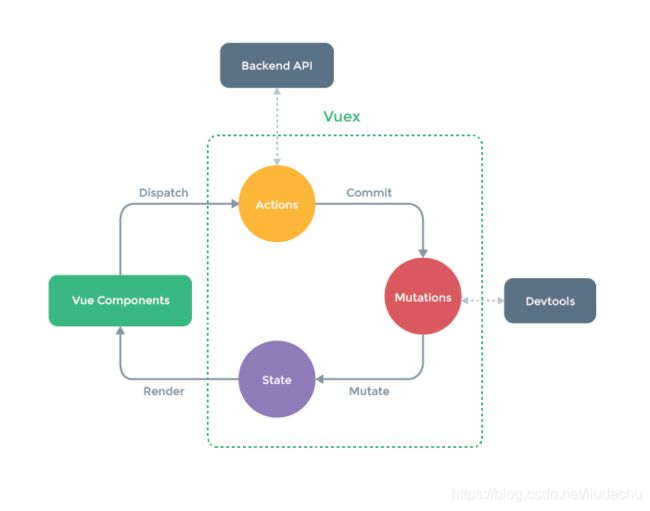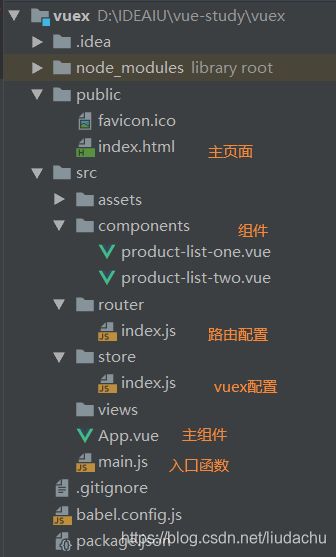VUEX官方入门-状态管理模式
十七、VUEX官方入门
1.介绍
Vuex 是什么?
Vuex 是一个专为 Vue.js 应用程序开发的状态管理模式。它采用集中式存储管理应用的所有组件的状态,并以相应的规则保证状态以一种可预测的方式发生变化。
什么是“状态管理模式”?
让我们从一个简单的 Vue 计数应用开始:
让我们从一个简单的 Vue 计数应用开始:
new Vue({
// state
data () {
return {
count: 0
}
},
// view
template: `
{{ count }}
`,
// actions
methods: {
increment () {
this.count++
}
}
})
这个状态自管理应用包含以下几个部分:
- state,驱动应用的数据源;
- view,以声明方式将 state 映射到视图;
- actions,响应在 view 上的用户输入导致的状态变化
以下是一个表示“单向数据流”理念的简单示意:
![]()
但是,当我们的应用遇到多个组件共享状态时,单向数据流的简洁性很容易被破坏:
- 多个视图依赖于同一状态。
- 来自不同视图的行为需要变更同一状态
对于问题一,传参的方法对于多层嵌套的组件将会非常繁琐,并且对于兄弟组件间的状态传递无能为力。对于问题二,我们经常会采用父子组件直接引用或者通过事件来变更和同步状态的多份拷贝。以上的这些模式非常脆弱,通常会导致无法维护的代码。
因此,我们为什么不把组件的共享状态抽取出来,以一个全局单例模式管理呢?在这种模式下,我们的组件树构成了一个巨大的“视图”,不管在树的哪个位置,任何组件都能获取状态或者触发行为!
通过定义和隔离状态管理中的各种概念并通过强制规则维持视图和状态间的独立性,我们的代码将会变得更结构化且易维护。
什么情况下我应该使用 Vuex?
Vuex 可以帮助我们管理共享状态,并附带了更多的概念和框架。这需要对短期和长期效益进行权衡。
如果您不打算开发大型单页应用,使用 Vuex 可能是繁琐冗余的。确实是如此——如果您的应用够简单,您最好不要使用 Vuex。一个简单的 store 模式就足够您所需了。但是,如果您需要构建一个中大型单页应用,您很可能会考虑如何更好地在组件外部管理状态,Vuex 将会成为自然而然的选择。引用 Redux 的作者 Dan Abramov 的话说就是:
Flux 架构就像眼镜:您自会知道什么时候需要它。
下载:
CDN
https://unpkg.com/vuex@2.0.0
npm
npm install vuex --save
在一个模块化的打包系统中,您必须显式地通过 Vue.use() 来安装 Vuex:
import Vue from 'vue'
import Vuex from 'vuex'
Vue.use(Vuex)
Vuex官网什么都有
2.核心概念
State
单一状态树
Vuex 使用单一状态树——是的,用一个对象就包含了全部的应用层级状态。至此它便作为一个“唯一数据源 (SSOT)”而存在。这也意味着,每个应用将仅仅包含一个 store 实例。单一状态树让我们能够直接地定位任一特定的状态片段,在调试的过程中也能轻易地取得整个当前应用状态的快照。
在 Vue 组件中获得 Vuex 状态
那么我们如何在 Vue 组件中展示状态呢?由于 Vuex 的状态存储是响应式的,从 store 实例中读取状态最简单的方法就是在计算属性中返回某个状态:
// 创建一个 Counter 组件
const Counter = {
template: `{{ count }}`,
computed: {
count () {
return store.state.count
}
}
}
每当 store.state.count 变化的时候, 都会重新求取计算属性,并且触发更新相关联的 DOM。
然而,这种模式导致组件依赖全局状态单例。在模块化的构建系统中,在每个需要使用 state 的组件中需要频繁地导入,并且在测试组件时需要模拟状态。
Vuex 通过 store 选项,提供了一种机制将状态从根组件“注入”到每一个子组件中(需调用 Vue.use(Vuex)):
const app = new Vue({
el: '#app',
// 把 store 对象提供给 “store” 选项,这可以把 store 的实例注入所有的子组件
store,
components: { Counter },
template: `
通过在根实例中注册 store 选项,该 store 实例会注入到根组件下的所有子组件中,且子组件能通过 this.$store 访问到。让我们更新下 Counter 的实现:
const Counter = {
template: `{{ count }}`,
computed: {
count () {
return this.$store.state.count
}
}
}
mapState 辅助函数(了解)
当一个组件需要获取多个状态的时候,将这些状态都声明为计算属性会有些重复和冗余。为了解决这个问题,我们可以使用 mapState 辅助函数帮助我们生成计算属性,让你少按几次键:
// 在单独构建的版本中辅助函数为 Vuex.mapState
import { mapState } from 'vuex'
export default {
// ...
computed: mapState({
// 箭头函数可使代码更简练
count: state => state.count,
// 传字符串参数 'count' 等同于 `state => state.count`
countAlias: 'count',
// 为了能够使用 `this` 获取局部状态,必须使用常规函数
countPlusLocalState (state) {
return state.count + this.localCount
}
})
}
当映射的计算属性的名称与 state 的子节点名称相同时,我们也可以给 mapState 传一个字符串数组。
computed: mapState([
// 映射 this.count 为 store.state.count
'count'
])
Getter
有时候我们需要从 store 中的 state 中派生出一些状态,例如对列表进行过滤并计数:
computed: {
doneTodosCount () {
return this.$store.state.todos.filter(todo => todo.done).length
}
}
如果有多个组件需要用到此属性,我们要么复制这个函数,或者抽取到一个共享函数然后在多处导入它——无论哪种方式都不是很理想。
Vuex 允许我们在 store 中定义“getter”(可以认为是 store 的计算属性)。就像计算属性一样,getter 的返回值会根据它的依赖被缓存起来,且只有当它的依赖值发生了改变才会被重新计算。
Getter 接受 state 作为其第一个参数:
const store = new Vuex.Store({
state: {
todos: [
{ id: 1, text: '...', done: true },
{ id: 2, text: '...', done: false }
]
},
getters: {
doneTodos: state => {
return state.todos.filter(todo => todo.done)
}
}
})
通过属性访问
Getter 会暴露为 store.getters 对象,你可以以属性的形式访问这些值:
store.getters.doneTodos // -> [{ id: 1, text: '...', done: true }]
Getter 也可以接受其他 getter 作为第二个参数:
getters: {
// ...
doneTodosCount: (state, getters) => {
return getters.doneTodos.length
}
}
store.getters.doneTodosCount // -> 1
我们可以很容易地在任何组件中使用它:
computed: {
doneTodosCount () {
return this.$store.getters.doneTodosCount
}
}
注意,getter 在通过属性访问时是作为 Vue 的响应式系统的一部分缓存其中的。
通过方法访问
你也可以通过让 getter 返回一个函数,来实现给 getter 传参。在你对 store 里的数组进行查询时非常有用。
getters: {
// ...
getTodoById: (state) => (id) => {
return state.todos.find(todo => todo.id === id)
}
}
store.getters.getTodoById(2) // -> { id: 2, text: '...', done: false }
注意,getter 在通过方法访问时,每次都会去进行调用,而不会缓存结果。
mapGetters 辅助函数
mapGetters 辅助函数仅仅是将 store 中的 getter 映射到局部计算属性:
import { mapGetters } from 'vuex'
export default {
// ...
computed: {
// 使用对象展开运算符将 getter 混入 computed 对象中
...mapGetters([
'doneTodosCount',
'anotherGetter',
// ...
])
}
}
如果你想将一个 getter 属性另取一个名字,使用对象形式:
...mapGetters({
// 把 `this.doneCount` 映射为 `this.$store.getters.doneTodosCount`
doneCount: 'doneTodosCount'
})
Mutations
更改 Vuex 的 store 中的状态的唯一方法是提交 mutation。Vuex 中的 mutation 非常类似于事件:每个 mutation 都有一个字符串的 事件类型 (type) 和 一个 回调函数 (handler)。这个回调函数就是我们实际进行状态更改的地方,并且它会接受 state 作为第一个参数:
const store = new Vuex.Store({
state: {
count: 1
},
mutations: {
increment (state) {
// 变更状态
state.count++
}
}
})
你不能直接调用一个 mutation handler。这个选项更像是事件注册:“当触发一个类型为 increment 的 mutation 时,调用此函数。”要唤醒一个 mutation handler,你需要以相应的 type 调用 store.commit 方法:
store.commit('increment')
提交载荷(Payload)
你可以向 store.commit 传入额外的参数,即 mutation 的 载荷(payload):
// ...
mutations: {
increment (state, n) {
state.count += n
}
}
store.commit('increment', 10)
在大多数情况下,载荷应该是一个对象,这样可以包含多个字段并且记录的 mutation 会更易读:
// ...
mutations: {
increment (state, payload) {
state.count += payload.amount
}
}
store.commit('increment', {
amount: 10
})
对象风格的提交方式
提交 mutation 的另一种方式是直接使用包含 type 属性的对象:
store.commit({
type: 'increment',
amount: 10
})
当使用对象风格的提交方式,整个对象都作为载荷传给 mutation 函数,因此 handler 保持不变:
mutations: {
increment (state, payload) {
state.count += payload.amount
}
}
Mutation 需遵守 Vue 的响应规则
既然 Vuex 的 store 中的状态是响应式的,那么当我们变更状态时,监视状态的 Vue 组件也会自动更新。这也意味着 Vuex 中的 mutation 也需要与使用 Vue 一样遵守一些注意事项:
- 最好提前在你的 store 中初始化好所有所需属性。
- 当需要在对象上添加新属性时,你应该
-
使用
Vue.set(obj, 'newProp', 123), 或者 -
以新对象替换老对象。例如,利用对象展开运算符我们可以这样写:
state.obj = { ...state.obj, newProp: 123 }
Mutation 必须是同步函数
一条重要的原则就是要记住 mutation 必须是同步函数。为什么?请参考下面的例子:
mutations: {
someMutation (state) {
api.callAsyncMethod(() => {
state.count++
})
}
}
现在想象,我们正在 debug 一个 app 并且观察 devtool 中的 mutation 日志。每一条 mutation 被记录,devtools 都需要捕捉到前一状态和后一状态的快照。然而,在上面的例子中 mutation 中的异步函数中的回调让这不可能完成:因为当 mutation 触发的时候,回调函数还没有被调用,devtools 不知道什么时候回调函数实际上被调用——实质上任何在回调函数中进行的状态的改变都是不可追踪的。
Mutation 必须是同步函数
一条重要的原则就是要记住 mutation 必须是同步函数。为什么?请参考下面的例子:
mutations: {
someMutation (state) {
api.callAsyncMethod(() => {
state.count++
})
}
}
现在想象,我们正在 debug 一个 app 并且观察 devtool 中的 mutation 日志。每一条 mutation 被记录,devtools 都需要捕捉到前一状态和后一状态的快照。然而,在上面的例子中 mutation 中的异步函数中的回调让这不可能完成:因为当 mutation 触发的时候,回调函数还没有被调用,devtools 不知道什么时候回调函数实际上被调用——实质上任何在回调函数中进行的状态的改变都是不可追踪的。
下一步:Action
在 mutation 中混合异步调用会导致你的程序很难调试。例如,当你调用了两个包含异步回调的 mutation 来改变状态,你怎么知道什么时候回调和哪个先回调呢?这就是为什么我们要区分这两个概念。在 Vuex 中,mutation 都是同步事务:
store.commit('increment')
// 任何由 "increment" 导致的状态变更都应该在此刻完成。
为了处理异步操作,让我们来看一看 Action。
Action
Action 类似于 mutation,不同在于:
- Action 提交的是 mutation,而不是直接变更状态。
- Action 可以包含任意异步操作。
让我们来注册一个简单的 action:
const store = new Vuex.Store({
state: {
count: 0
},
mutations: {
increment (state) {
state.count++
}
},
actions: {
increment (context) {
context.commit('increment')
}
}
})
Action 函数接受一个与 store 实例具有相同方法和属性的 context 对象,因此你可以调用 context.commit 提交一个 mutation,或者通过 context.state 和 context.getters 来获取 state 和 getters。
分发 Action
Action 通过 store.dispatch 方法触发:
store.dispatch('increment')
乍一眼看上去感觉多此一举,我们直接分发 mutation 岂不更方便?实际上并非如此,还记得 mutation 必须同步执行这个限制么?Action 就不受约束!我们可以在 action 内部执行异步操作:
actions: {
incrementAsync ({ commit }) {
setTimeout(() => {
commit('increment')
}, 1000)
}
}
Actions 支持同样的载荷方式和对象方式进行分发:
// 以载荷形式分发
store.dispatch('incrementAsync', {
amount: 10
})
// 以对象形式分发
store.dispatch({
type: 'incrementAsync',
amount: 10
})
来看一个更加实际的购物车示例,涉及到调用异步 API 和分发多重 mutation:
actions: {
checkout ({ commit, state }, products) {
// 把当前购物车的物品备份起来
const savedCartItems = [...state.cart.added]
// 发出结账请求,然后乐观地清空购物车
commit(types.CHECKOUT_REQUEST)
// 购物 API 接受一个成功回调和一个失败回调
shop.buyProducts(
products,
// 成功操作
() => commit(types.CHECKOUT_SUCCESS),
// 失败操作
() => commit(types.CHECKOUT_FAILURE, savedCartItems)
)
}
}
注意我们正在进行一系列的异步操作,并且通过提交 mutation 来记录 action 产生的副作用(即状态变更)。
在组件中分发 Action
你在组件中使用 this.$store.dispatch('xxx') 分发 action,或者使用 mapActions 辅助函数将组件的 methods 映射为 store.dispatch 调用(需要先在根节点注入 store):
import { mapActions } from 'vuex'
export default {
// ...
methods: {
...mapActions([
'increment', // 将 `this.increment()` 映射为 `this.$store.dispatch('increment')`
// `mapActions` 也支持载荷:
'incrementBy' // 将 `this.incrementBy(amount)` 映射为 `this.$store.dispatch('incrementBy', amount)`
]),
...mapActions({
add: 'increment' // 将 `this.add()` 映射为 `this.$store.dispatch('increment')`
})
}
}
组合 Action
Action 通常是异步的,那么如何知道 action 什么时候结束呢?更重要的是,我们如何才能组合多个 action,以处理更加复杂的异步流程?
首先,你需要明白 store.dispatch 可以处理被触发的 action 的处理函数返回的 Promise,并且 store.dispatch 仍旧返回 Promise:
actions: {
actionA ({ commit }) {
return new Promise((resolve, reject) => {
setTimeout(() => {
commit('someMutation')
resolve()
}, 1000)
})
}
}
现在你可以:
store.dispatch('actionA').then(() => {
// ...
})
在另外一个 action 中也可以:
actions: {
// ...
actionB ({ dispatch, commit }) {
return dispatch('actionA').then(() => {
commit('someOtherMutation')
})
}
}
最后,如果我们利用 async / await,我们可以如下组合 action:
// 假设 getData() 和 getOtherData() 返回的是 Promise
actions: {
async actionA ({ commit }) {
commit('gotData', await getData())
},
async actionB ({ dispatch, commit }) {
await dispatch('actionA') // 等待 actionA 完成
commit('gotOtherData', await getOtherData())
}
}
一个
store.dispatch在不同模块中可以触发多个 action 函数。在这种情况下,只有当所有触发函数完成后,返回的 Promise 才会执行。
3.Vuex小案例
项目结构
案例效果:
使用getters中的saleProducts()方法返回修改过后的资产数据,并显示在页面上
当点击‘资产减少’的按钮的时候,触发reducePrice方法,调用actions中的reducePrice方法,actions调用mutations中的reducePrice方法,mutations修改state中的数据,并显示在页面上
[外链图片转存失败,源站可能有防盗链机制,建议将图片保存下来直接上传(img-qGDAIm4k-1601375695439)(C:\Users\Chef Liu\AppData\Roaming\Typora\typora-user-images\image-20200926130245168.png)]
main.js入口文件
import Vue from 'vue'
import App from './App.vue'
import router from './router'
import store from './store'
Vue.config.productionTip = false
new Vue({
router,
store,
render: h => h(App)
}).$mount('#app')
store/index.js vuex配置文件
import Vue from 'vue'
import Vuex from 'vuex'
Vue.use(Vuex);
export default new Vuex.Store({
state: {
products:[
{name:'马云',price:200},
{name:'马化腾',price:140},
{name:'马冬梅',price:20},
{name:'马蓉',price:10},
]
},
getters:{
saleProducts:(state)=>{
let salProducts=state.products.map(product=>{
return {
name:"**"+product.name+"**",
price:product.price/2
};
});
return salProducts;
},
},
mutations: {
reducePrice:(state,payload) => {
state.products.forEach(product=>{
product.price-=payload;
})
}
},
actions: {
reducePrice:(context,payload)=>{
setTimeout(function () {
//与 store 实例具有相同方法和属性的 context 对象
context.commit("reducePrice",payload)
},2000);
}
},
modules: {
}
})
App.vue 根组件
<template>
<div id="app">
<product-list-one>product-list-one>
<product-list-two>product-list-two>
div>
template>
<script>
import productListOne from './components/product-list-one.vue'
import productListTwo from './components/product-list-two.vue'
export default{
name:'app',
components:{
'product-list-one':productListOne,
'product-list-two':productListTwo,
},
}
script>
<style>
body{
font-family: "微软雅黑";
color: #555;
}
style>
product-list-one.vue 组件1
<template>
<div id="product-list-one">
<h2>Product-list-oneh2>
<ul>
<li v-for="product in saleProducts">
<span class="name">{{product.name}}span>
<span class="price"> ${{product.price}}span>
li>
ul>
<button @click="reducePrice(4)">资产减少button>
div>
template>
<script>
import {mapGetters} from 'vuex';
import {mapActions} from 'vuex';
export default {
name: "product-list-one",
computed:{//计算属性,从vuex.store中的state获取数据
products(){
return this.$store.state.products;
},
saleProducts(){
return this.$store.getters.saleProducts;
}
/*
以上返回getters中的方法 可以使用mapGetters替换
//ES6新语法
...mapGetters([
"saleProducts",
"",
])
*/
},
methods:{
/*reducePrice:function (amount) {
//1.使用mutations中的方法
//this.$store.commit('reducePrice');
//2.分发actions中的方法
this.$store.dispatch('reducePrice',amount);
},*/
/*
以上返回getters中的方法 可以使用mapActions替换*/
...mapActions([
"reducePrice",
"",
])
}
}
script>
<style scoped>
#product-list-one{
background: #FFF8B1;
box-shadow: 1px 2px 3px rgba(0,0,0,0.2);
margin-bottom: 30px;
padding: 10px 20px;
}
#product-list-one ul{
padding: 0;
}
#product-list-one li{
display: inline-block;
margin-right: 10px;
margin-top: 10px;
padding: 20px;
background: rgba(255,255,255,0.7);
}
.price{
font-weight: bold;
color: #E8800C;
}
style>
product-list-two.vue 组件2
<template>
<div id="product-list-two">
<h2>Product-list-twoh2>
<ul>
<li v-for="product in saleProducts">
<span class="name">{{product.name}}span>
<span class="price">${{product.price}}span>
li>
ul>
div>
template>
<script>
export default {
name: "product-list-two",
computed:{//计算属性,从vuex.store中的state获取数据
products(){
return this.$store.state.products;
},
saleProducts(){
return this.$store.getters.saleProducts;
}
}
}
script>
<style scoped>
#product-list-two{
background: #D1E4EF;
box-shadow: 1px 2px 3px rgba(0,0,0,0.2);
margin-bottom: 30px;
padding: 10px 20px;
}
#product-list-two ul{
padding: 0;
list-style-type: none;
}
#product-list-two li{
margin-right: 10px;
margin-top: 10px;
padding: 20px;
background: rgba(255,255,255,0.7);
}
.price{
font-weight: bold;
color: #860CE8;
display: block;
}
style>
vuex完结。

